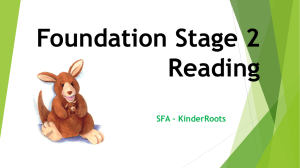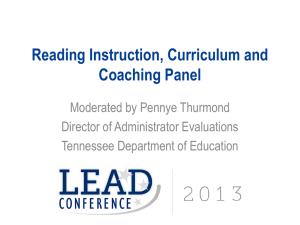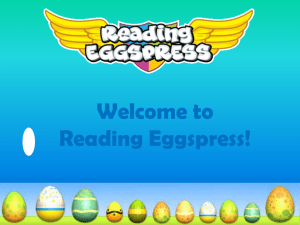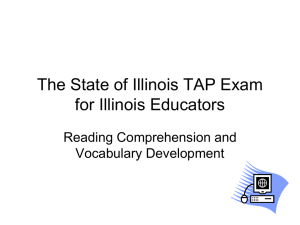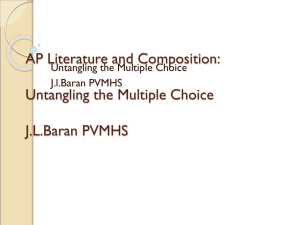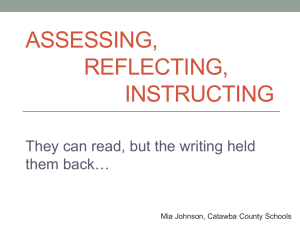The Reading Process (2)
advertisement
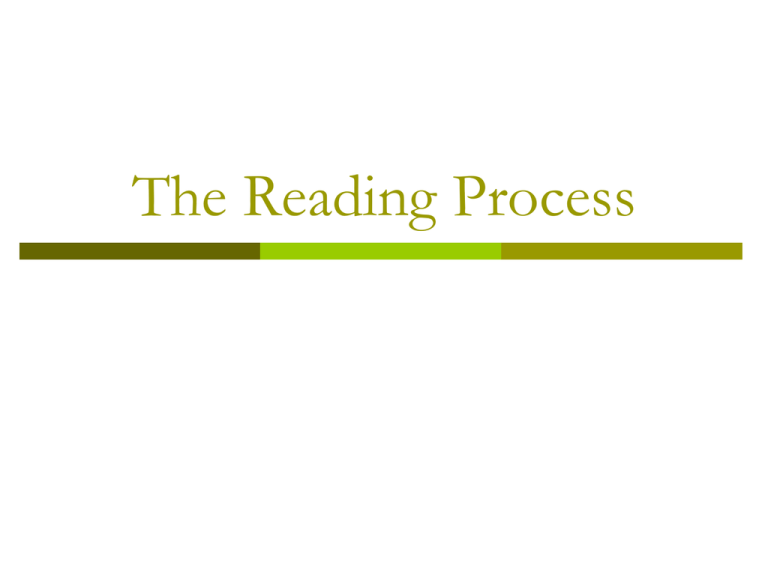
The Reading Process Overview of Session Components of Reading Instruction Arch Assessment (Dawn Reithaug, 2002, adapted by Julie Acott, 2009) Paragon-lead.com Travelblog.org Phonological Awareness Highlands.k12.fl.us Strategies for Comprehension Phonics trendsupdates.com Letter Recognition Resources for Instruction SEP Outcomes Educatorsbookbag.com doap.wordpress.com web.pacific.edu Students need to be involved in authentic reading, writing, speaking and listening tasks to develop as readers, writers and oral communicators. Components of Reading Instruction Arch Reading Decoding - Fluency - Comprehension Strategies for Comprehending Text Letter Phonological HighFrequency Phonics Recognition Awareness Words #1 #2 Vocabulary Oral Language (Dawn Reithaug, 2002, adapted by Julie Acott, 2009) Components of Reading Instruction ArchDecoding Phonics – Letter-Sound Relationships linking letter symbols with sounds blending these sounds to form words Phonics Regular connections Blends Diagraphs Assessment – pages 29 - 36 Larger groupings of letters Vowel Combinations Components of Reading Instruction Arch Decoding • Letter Recognition - #1: - distinguishing features - purposes (upper-and lowercase) (Fountas and Pinnell, When Reades Struggle, 2009) Assessment – pages 5-7 Components of Reading Instruction Arch Decoding Phonological Awareness • Sounds in language Blend /c/-/a/-/t/ = cat Assessment – pages 8-20 rhyming Segment Manipulate Cat = /c/-/a/-/t/ Cat - /m/ - mat •Sentences •Word Parts (compound words/syllables • Word Parts (compound words/syllables) •Word Bases (onset/rime) •Word Bases (onset/rime) •Phonemes (smallest unit of sound) •Phonemes (smallest unit of sound) Components of Reading Instruction Arch Decoding Two other pieces to consider: Alphabet Principal – pages 21-23 High-frequency words – can use the Dolch word list – see word list Overview of Session Components of Reading Instruction Arch Assessment (Dawn Reithaug, 2002, adapted by Julie Acott, 2009) Paragon-lead.com Travelblog.org Phonological Awareness Highlands.k12.fl.us Resources for Instruction Strategies for Comprehension Phonics trendsupdates.com Letter Recognition Educatorsbookbag.com web.pacific.edu SEP Outcomes doap.wordpress.com Components of Reading Instruction Arch Comprehension Vocabulary: Understanding the meaning of words Using them flexibly and with precision to help make sense of the text Assessment - pages 24-28 Components of Reading Instruction Arch Comprehension Three Levels of Comprehension: CAMET 1. Literal – page 9 2. Inferential/Interpretive – page 10 3. Personal/Critical/Evaluative – page 10 Components of Reading Instruction Arch Comprehension Levels of Comprehension Strategies 1. 2. 3. 4. 5. 6. 7. 8. Determining Importance Visualizing Inferring Making Connections Critiquing/Evaluating Asking Questions Retelling, Summarizing, Synthesizing Self-Monitoring Assessment – ACRA and OCA Comprehension - Literal - Interpretative - Inferential - Personal - Critical/evaluative - All three - All three - Metacognition – GCO 4 – 1st – 2nd – 2nd – 3rd – 3rd Components of Reading Instruction Arch Reading Decoding - Fluency - Comprehension Strategies for Comprehending Text Letter Phonological HighFrequency Phonics Recognition Awareness Words #1 #2 Vocabulary Oral Language (Dawn Reithaug, 2002, adapted by Julie Acott, 2009) Components of Reading Instruction Arch Fluency: How quickly and accurately a text is read with proper expression Links word recognition and comprehension Running Records help determine this Essential Components of Reading Phonemic Awareness Letter Recognition Phonics Highfrequency Words Fluency Vocabulary Comprehension Strategies Identifying words accurately Identifying words quickly and reading with expression Constructing meaning once words are identified Selecting the most effective instructional practices and interventions for students requires educators to be knowledgeable about what works – what students need to be able to do in each essential component of reading so they can become proficient readers. Dawn Reithaug, 2009 Three Possible Scenarios: Scenario 1 Difficulty with decoding but strong oral vocabularies and oral language Dawn Reithaug, 2009 Components of Reading Instruction Arch Reading Decoding - Fluency - Comprehension #1 Vocabulary #2 Letter Phonological Recognition Awareness Strategies for Comprehending Text HighFrequency Words Oral Language (Dawn Reithaug, 2002, adapted by Julie Acott, 2009) Scenario 2 Able to decode but have difficulty comprehending grade level text: a. low vocabulary b. inadequate strategies for comprehending text Dawn Reithaug, 2009 Components of Reading Instruction Arch Reading Decoding - Fluency - Comprehension Vocabulary Letter Phonological HighFrequency Phonics Recognition Awareness Words #1 #2 Oral Language (Dawn Reithaug, 2002, adapted by Julie Acott, 2009) Scenario 3 Difficulty with decoding and comprehension Dawn Reithaug, 2009 Components of Reading Instruction Arch Reading Decoding - Fluency - Comprehension Strategies for Comprehending Text HighFrequency Words Vocabulary Phonological Awareness #2 Oral Language (Dawn Reithaug, 2002, adapted by Julie Acott, 2009) It is very important for educators to know what scenario fits with certain students so time is not wasted on teaching skills and strategies students already know. Getting the right fit starts with assessing students in some or all of the components of reading to find out what instructional practices or interventions each student needs. Dawn Reithaug, 2009 Four Types of Assessment Screening Diagnostic Progress Monitoring Outcome – – all students – teacher – specific students – R&M – all students – teacher and/or R&M all students – teacher and/or R&M Overview of Session Components of Reading Instruction Arch Assessment (Dawn Reithaug, 2002, adapted by Julie Acott, 2009) Paragon-lead.com Travelblog.org Phonological Awareness Highlands.k12.fl.us Strategies for Comprehension Phonics trendsupdates.com Letter Recognition Resources for Instruction SEP Outcomes Educatorsbookbag.com doap.wordpress.com web.pacific.edu
